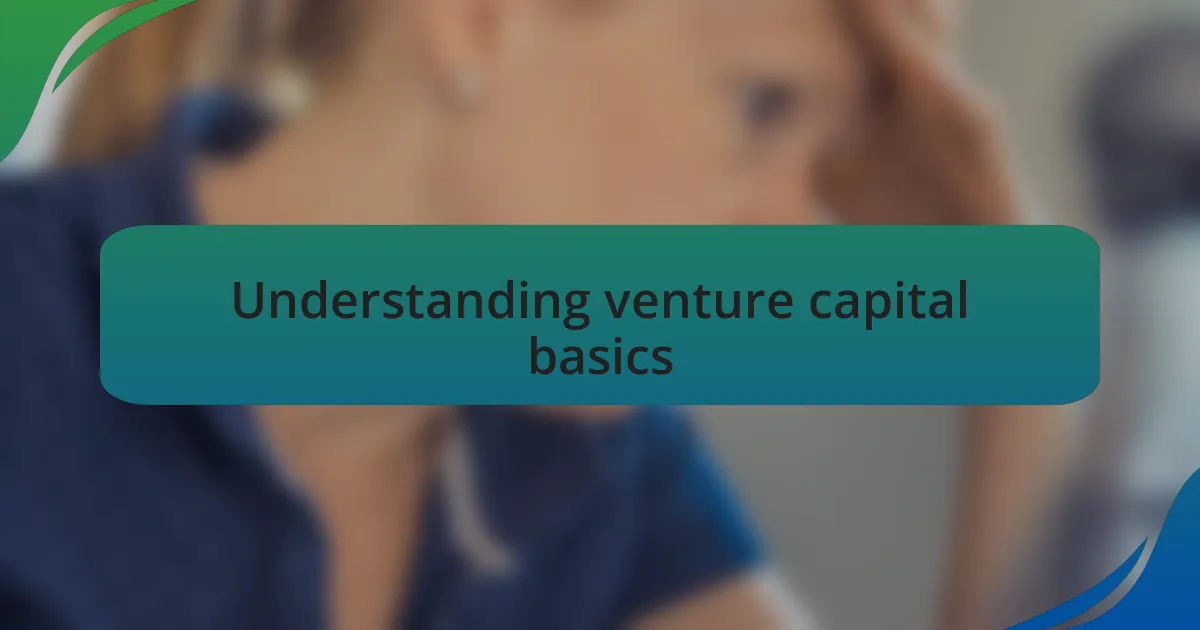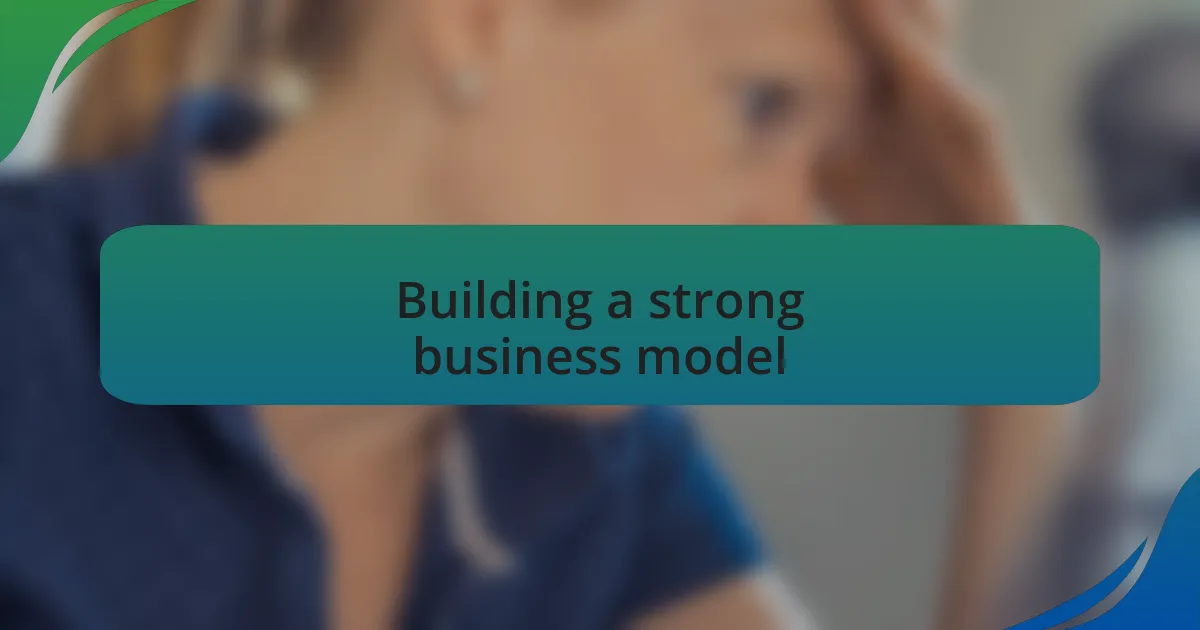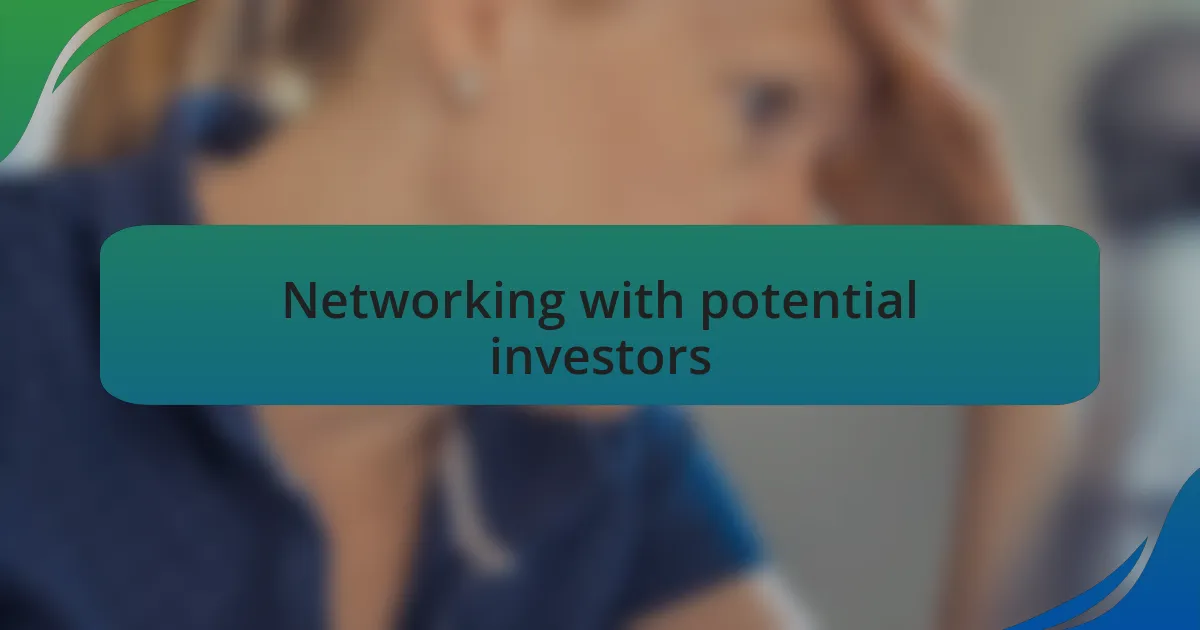Key takeaways:
- Venture capital involves risk; investors seek high returns, knowing many startups may fail.
- A strong business model must clearly articulate value, demonstrate financial sustainability, and showcase scalability.
- Crafting an impactful pitch integrates storytelling, visuals, and practice to engage investors effectively.
- Networking is vital; building genuine relationships can lead to unexpected funding opportunities.

Understanding venture capital basics
Venture capital is essentially a form of financing that investors provide to startups and small businesses with perceived long-term growth potential. When I first encountered this world, I was struck by how much it resembles a partnership; investors are not just handing over money—they’re looking for commitment, vision, and a strong execution plan. Have you ever thought about how powerful an ally a good investor can be, not only in terms of funding but also in networking and expertise?
One of the most surprising aspects for me was understanding the risk involved. Investors often put their money into nascent companies expecting that a significant percentage will fail. This raises a critical question: why would they take such risks? It all boils down to the potential for high returns; a single successful investment can offset multiple failures. So, as you consider pursuing venture capital, think about how your business idea stands out in this high-stakes game.
Then there’s the matter of equity. Accepting venture capital often means giving up a portion of your company, which can be a tricky emotional hurdle to navigate. I remember grappling with the idea that I would no longer be the sole decision-maker. It’s crucial to consider whether you’re ready to share that responsibility and how much you value the guidance and resources that investors can bring. Have you ever weighed the pros and cons of such an arrangement? Balancing control with growth potential is an essential step in this journey.

Key factors attracting venture capital
When it comes to attracting venture capital, a compelling business model is non-negotiable. I’ve found that investors want to see a clear path to profitability, or at the very least, a viable plan that shows how you’ll reach that milestone. Have you ever considered how a well-thought-out financial projection can not only validate your idea but also inspire confidence in potential investors?
Another vital factor is the strength of your team. Investors often evaluate not just your product but the people behind it. I vividly remember the moment I understood that during pitches, investors were not just assessing my business plan. They were scrutinizing my passion and my team’s ability to execute. It’s fascinating to think that your team’s dynamics and expertise could be the deciding factor that sways an investor’s interest.
Market potential also plays a crucial role. I realized through my experience that showcasing a growing market can significantly enhance your appeal. If your target audience is sizable and your product addresses a real need, it paints a picture of opportunity. Engaging investors with compelling insights about your market can make them visualize not just a return on their investment, but a chance to be part of something larger. What would you highlight about your market to entice investors?

Building a strong business model
A strong business model is all about clarity. I remember refining my value proposition after countless discussions with mentors. It became clear that being able to articulate how my product solves a specific problem was key. Have you ever tried explaining your business to someone outside your industry? This exercise often reveals gaps in understanding that, once addressed, can make your model much stronger in the eyes of investors.
In my experience, financial sustainability is another pillar of a robust business model. I learned this the hard way when my early projections were overly optimistic. Investors need to see realistic numbers—they want to know you can not only survive but thrive. When I adjusted my financial forecasts to reflect achievable milestones, the conversations with investors shifted dramatically from skepticism to genuine interest.
Moreover, scalability is essential. I vividly recall the moment an investor expressed concern about my business plateauing. That feedback prompted me to rethink how my model could expand over time. It’s essential to show how your business can evolve, so ask yourself: how can your business model adapt to changing markets or customer needs? Answering that question not only strengthens your pitch but also allows you to envision future growth.

Crafting an impactful pitch
Crafting a compelling pitch is more than just sharing numbers and facts; it’s about storytelling. I remember a time when I focused intently on my passion for the problem my startup was solving, rather than just the product itself. It was during a presentation when I saw the investors’ eyes light up as I articulated my vision. Have you ever shared a story so captivating that it drew your audience in completely? When I transformed my pitch into a narrative that highlighted real-life experiences, it resonated much more deeply.
Another lesson I learned was the power of visuals. Early on, I relied heavily on lengthy slides filled with text. After receiving feedback, I experimented with infographics and images. The shift was remarkable; the visuals sparked conversations and made my points memorable. How often do we overlook the impact of what we see? By incorporating visuals that aligned with my core message, I found that investors were more engaged and retained information better.
Finally, practice cannot be underestimated. I vividly recall rehearsing my pitch in front of friends who weren’t shy about sharing their feedback. Each iteration refined not only my delivery but also my confidence. Have you ever felt that rush of excitement right before a big pitch? Channeling those nerves into preparation helped me convey authenticity and passion, and that connection often turned skeptics into supporters.

Networking with potential investors
Building genuine relationships with potential investors is essential. I recall attending a networking event where I met an investor who was not looking for immediate opportunities but was intrigued by my insights on industry trends. That conversation blossomed into a mentor-like relationship, which eventually opened doors to funding channels I hadn’t considered. Have you ever noticed how the right conversation can yield unexpected opportunities?
Moreover, I found that the value of networking extends beyond formal settings. Sharing my journey with fellow entrepreneurs over coffee led to invaluable introductions. I learned that talking about challenges and listening to others fosters trust. How often do you leverage informal conversations to expand your network? These authentic interactions build a foundation that investors appreciate when assessing the credibility of a founder.
Finally, I made it a point to follow up after each meeting. A simple thank-you note or an email referencing a shared insight goes a long way. One time, I sent a note to an investor after attending one of their talks. The response was encouraging, and it led to a productive conversation about my business. Maintaining contact demonstrates my commitment and keeps opportunities alive. Doesn’t cultivating these connections feel rewarding in itself?

Lessons learned from my experience
One of the most significant lessons I learned was the importance of resilience. I remember a pitch I gave that didn’t go as planned; the investor’s feedback was blunt and quite discouraging. Initially, it stung, but reflecting on that experience helped me refine my approach. Have you ever felt rejected and then realized it propelled you to improve? I learned that each setback could be a setup for a comeback if I stayed focused on my goals.
Another valuable insight was the need for clarity in my vision. During an early investor meeting, I struggled to clearly articulate my business model. The investor’s puzzled expression made me realize that if I couldn’t explain my vision succinctly, how could I expect anyone else to understand its potential? From that moment onward, I focused on developing a concise pitch that highlighted not just my idea but also why it mattered. It made a world of difference. Have you taken the time to practice articulating your vision?
Lastly, I discovered the power of authenticity in my storytelling. Investors want to connect on a personal level, and I found that sharing my journey—its ups and downs—created a bridge between us. I vividly recall telling an investor about a moment of vulnerability I faced in my startup. His response was heartfelt, leading to a deeper conversation about not just my business but my values. Isn’t it fascinating how vulnerability can transform a business discussion into something so much more meaningful?